Loops of Zen is a completely addictive puzzle game, in which you must rotate a grid full of puzzle shapes in order to form complete loops, with no disconnected ends.
After a few weeks playing this game, I’ve developed a few strategies that are effective tools for finding a valid solution to every board.
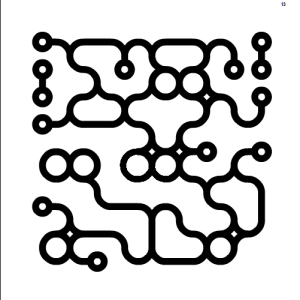
Read on for more about Loops of Zen…
[TOC]
Overview – Loops of Zen
Let’s take a look at the game and its mechanics…
Links
Play online:
Loops of Zen on Kongregate
Play on Android:
Loop (Order of Chaos) on Google Play
Rules
- There are 5 types of symbols.
- Each symbol rotates 90 degrees clockwise, within its cell, when clicked.
- Pieces can’t be moved, other than to be rotated.
- The board ends when all open ends are connected (no open ends remaining)
- Pieces can have 1 end, 2 ends (2 varieties), 3 ends or 4 ends.
- Some boards have blank cells that do not contain a symbol.
- Some levels are pre-rendered, while others are programmatically generated.
The beginning of the puzzle looks like this:

A winning board looks like this:

Due to the nature of the game mechanics, there are often multiple, slightly-varying, “winning” configurations.
Symbol Analysis
Due to the configuration of each symbol, certain rules must apply – for example, straight pieces with ends that are 180 degrees apart can’t occur on a corner, because both ends can’t be connected concurrently – one end will always “dangle” off the edge of the board.
Cap
The “Cap” can terminate a “loop”, and has one open end, as well as one closed end. The open end can be connected to any other shape. The cap can appear in any cell on the board, in any valid orientation.
| Shape: |
“Cap” |
| Ends: |
1 |
| Possible Orientations: |
|
| Valid Edge Orientations: |
3 Valid, 1 Invalid |
| Valid Corner Orientations: |
2 Valid, 2 Invalid |
Corner
The corner has two open ends, oriented 90 degrees apart, and can connect to any other shape. The corner may appear in any cell position, in any valid orientation.
| Shape: |
“Corner” |
| Ends: |
2, 90 degrees |
| Possible Orientations: |
|
| Valid Edge Orientations: |
2 Valid, 2 Invalid |
| Valid Corner Orientations: |
1 Valid, 3 Invalid |
“I”
The “I” has two ends, oriented 180 degrees apart, and therefore, has 180 degree rotational symmetry. The I has two ends, and connects to two other symbols. The I can appear on any interior cell, as well as edge cells in a parallel orientation, but may not appear on a corner cell.
| Shape: |
“I” |
| Ends: |
2, 180 degrees |
| Possible Orientations: |
(180 degree rotational symmetry) |
| Valid Edge Orientations: |
1 Valid, 1 Invalid |
| Valid Corner Orientations: |
This shape will never appear on a corner. |
“T”
The “T” has 3 open ends, and can connect to 3 other shapes. The T can appear in any interior cell, as well as edge cells in the proper orientation, but not corner cells.
| Shape: |
“T” |
| Ends: |
3 |
| Possible Orientations: |
|
| Valid Edge Orientations: |
1 Valid, 3 Invalid |
| Valid Corner Orientations: |
This shape will never appear on a corner. |
Cross
The “Cross” has 4 open ends, and can connect to 4 other symbols. Due to its configuration, it has 90 degree rotational symmetry (thus, even though the symbol CAN be rotated, rotating this symbol has no effect). The cross can ONLY appear in an interior cell, and can not appear on an edge or corner.
| Shape: |
“Cross” |
| Ends: |
4 |
| Possible Orientations: |
(90 degree rotational symmetry) |
| Valid Edge Orientations: |
This shape will never appear on an edge. |
| Valid Corner Orientations: |
This shape will never appear on a corner. |
Strategies
List of “Loops of Zen” Strategies
Here is a list of rules to follow, for helping to solve any board. We’ll delve in to each of these in more detail.
- “Properly-oriented” means that, through logical deduction, there can be only one orientation for a specific shape, due to board position and/or the position of other adjacent, properly-oriented shapes.
- Edge and corner shapes must be oriented, pointing inward (away from the edge / corner, toward the center of the board).
- Shapes must be oriented, pointing away from empty cells within the interior of the board.
- Crosses are always properly oriented.
- If a shape is properly-oriented, the shape at each adjacent end must connect – therefore, the proper orientation for any shape adjacent to the end of a properly-oriented shape must be with one of its ends connecting.
- Any shape that is adjacent, but not connected to a properly-oriented shape must point away from that shape.
- Once properly oriented, adjacent, non-connecting “I” shapes must be oriented in parallel. Likewise, a “T” that is adjacent but not connected to an “I” must be oriented with the bottom of the “T” facing away from the “I”. In addition, two “T” shapes, non-connecting but adjacent, must have their bottoms pointing away from each other.
The rules above give rise to the following, additional rules:
- A cap adjacent to a cross, connects to the cross.
- An “I” adjacent to a cross, connects to the cross.
- If three corners connect in series to a fourth corner, if the first corner doesn’t have another option for connecting to an adjacent shape, then the four must form a circle with the first three.
- Two adjacent “T” shapes can be used to create or consume two free ends.
- Along an edge, adjacent “I” or “T” shapes must connect to adjacent “I” or “T” shapes. A chain of “I” and / or “T” shapes along an edge will always be bounded by corners and / or caps.
Description of Strategies
Rule 1: Properly Oriented
“Properly-oriented” means that, through logical deduction, there can be only one orientation for a specific shape, due to board position and/or the position of other adjacent, properly-oriented shapes.

On the left, we see that one end of a “Corner” piece, located on the corner of the board, is pointing in a direction that would preclude connecting one of the ends. Simple analysis reveals that there are three orientations in which one of the two ends would “dangle” off the board. Therefore, on the right, you can see the ONE valid orientation – the corner shape on the right is therefore “properly-oriented”.

On an edge cell, the same “Corner” shape can have two possible valid orientations, and therefore, we don’t know it’s “proper” orientation without additional information – for example, is one of the cells blank, or is there another, properly-oriented shape adjacent to it?
Rule 2: Edge and Corner Shapes Point Inward
This is simply the definition of valid edge and corner orientations for each shape. A shape can’t be oriented such that one of its unconnected ends would “dangle” off the board.
|
|
|
|
|
|
|
|
|
Rule 3: Shapes Must Point Away From Empty Cells
This is simply an extension of the edge and corner rule. Empty cells can essentially be treated as edges and corners. Therefore, there can’t be an unconnected edge pointing toward an adjacent, empty cell, because there is now way to complete the circuit.
Rule 4: Crosses Are Always Properly Oriented
This is self-explanatory, but crosses can’t appear on corner or edge cells.
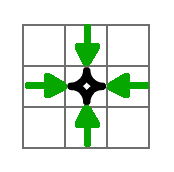 In addition to the fact that rotation has no effect, each adjacent shape must connect to it (Rule 5).
In addition to the fact that rotation has no effect, each adjacent shape must connect to it (Rule 5).
Rule 5: Adjacent Shapes Must Connect
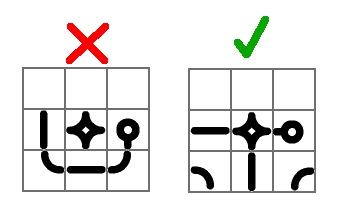
On the left, what at first appears to be a proper chain of shapes, is actually incorrectly oriented. Every shape adjacent to a cross must connect to it. On the right, we see the proper orientation. The two corner pieces are part of some other chain, but due to Rule 6, we know that these corners must point “away” from the cross and its properly-oriented, adjacent shapes.
Other examples are adjacent edge shapes that must connect to each other, or risk dangling off the board, or a corner shape appearing at the corner of the board, that, no matter how odd it appears, must connect to its two adjacent shapes.
If a shape is properly-oriented, and it presents an end to an adjacent cell, then the shape in the adjacent cell must connect, or else the circuit is broken. Conversely, if a shape that is thought to be properly-oriented presents a connecting end to an adjacent cell that precludes connectivity back to the shape itself, then the shape itself isn’t properly-oriented.
Rule 6: Adjacent, Unconnected Shapes Must Point Away from Properly-Oriented Shapes

Looking at our previous example for rule 5, on the right, we see that once the “I” shapes are properly oriented, there is no possible way that the adjacent corner shapes could possibly connect.
Therefore, without the possibility for a common free end, the corners must point “away” from the shapes to which they’re incapable of connecting.
Rule 7: Adjacent, Unconnected “I” and “T” Shapes Must Be Parallel
This is a bit complicated, so bear with me…
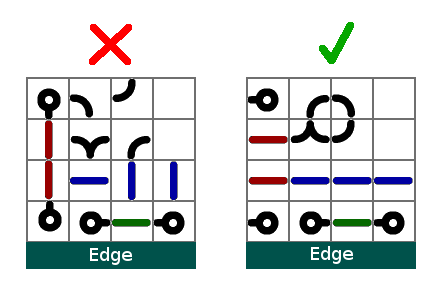
On the left, which is incorrect, we see that the green line at the bottom is next to an edge. Through rule 2, we know it can’t dangle off the edge of the board, so we know it’s properly oriented. Further, we know that it’s two connecting caps are properly oriented, through rule 5. So we know that the green line plus it’s connecting caps form a complete chain.
At first, the red line on the left side of the board appears to be properly oriented, because it connects neatly to two caps at each end of the chain, but this is incorrect.
The blue lines are adjacent to the green, and we know that the green line and its caps are properly-oriented, therefore they must all be oriented in parallel to the green line.
Through rule 5, we know that the red lines are therefore, not properly oriented.
On the right, we see the correct orientation for each shape:
- The green line and its caps were already properly oriented
- The blue line segments must all connect, and are parallel to green
- The red line segments must also run parallel to green and blue. One red segment connects to blue, while the other connects to the “T” at the top.
- The “T” shape must point away from the properly-oriented blue line segment adjacent to it. If not, the bottom of the “T” would present an unconnected end to the blue line.
- Using rules 5 and 3, we can deduce that the three corner shapes, along with the “T”, must form a loop.
- Further application of rule 6 requires that the cap shapes, originally connected to the red line, must point away (to the left) of the properly-oriented shapes.
Stated another way… all of these situations must be true, or else an adjacent but unconnected shape would present an unconnected end to the first shape, and thus the circuit of the adjacent shape would be incomplete:
- Part 1: If an “I” shape is properly-oriented, an adjacent but unconnected “I” shape must be parallel.
- Part 2: If an “I” shape is properly-oriented, an adjacent but unconnected “T” shape must be oriented with the top of the “T” parallel to the “I”, and the base of the “T” pointing away from the “I”.
- Part 3: If a “T” shape is properly-oriented, an adjacent but unconnected “I” shape must be oriented parallel to the top of the “T”.
- Part 4: If two “T” shapes are adjacent, and one is properly-oriented but unconnected, then the neighbor must be oriented with the top of its “T” parallel to the top of the properly-oriented one, and the two bases face away from each other.
Analysis of Effectiveness
Because there are multiple “valid” configurations for most of the boards, it’s often not possible to 100% logically deduce “one proper” solution to every board.
Further, as the number of “cap” shapes increases, the number of possible valid solutions increases, meaning that boards with a large number of cap shapes is very difficult to attack using these strategies.
Each board starts as a valid solution, which is then carved up in to cells, and whose cells are then rotated randomly. Therefore, we know each board must have at least one valid solution.
As we add pairs of cap shapes, any two adjacent cap shapes may result in an alternate solution, because they can either terminate two separate chains, or they can connect to each other to form a complete chain.
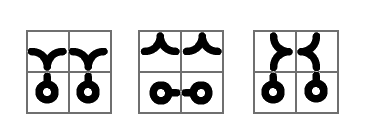
In the example above, we see three, possibly-valid solutions where two caps are adjacent to two “T” shapes. In the greater context, there may be other shapes that can be oriented to fit only one, multiple, or all of these variations.
In two of these variations, each “T” connects to a cap, and in the third variation, the two caps simply connect to each other.
If we were to construct a board consisting only of cap shapes, each block of 4 caps can have two possible valid solutions (rule 6):
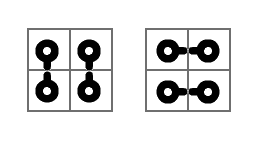
This pattern would repeat infinitely, for any board size, given one edge of the board must have an even number of cells in order to form a complete set of paths.
The only other shape that can form a complete board by itself is the corner. Each 2 x 2 block of corner cells must form a complete circle (rules 2, 5 and 6).
If the upper-right corner represents a corner of the board, the corner shape must point inward (2), and it must connect to its two adjacent neighbors (5), while pointing away from the edge (2). Therefore, the lower-left shape must connect to both the upper-left, and lower-right shapes (5)
If we have this configuration:
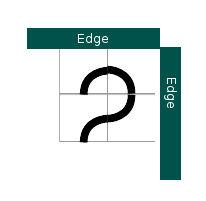
The only valid solution is this:

Due to rules 5 and 6, we can continue to configure each neighboring 2 x 2 block of corner shapes, accordingly.
This tessellation accommodates any board size with both an even width and even height.
Any other attempt to formulate a closed, space-filling curve using only corner pieces results in gaps:

In this tessellation, the corners, if joined, can be filled by a circle. However, at the extreme corners of the board, there is no way to accommodate a single corner shape, other than to form a circle with its adjacent neighbors.
Here are some additional examples:
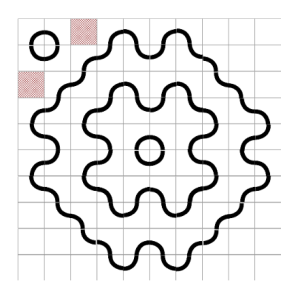
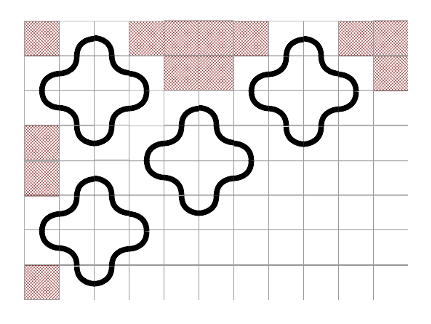
All of the other shapes, when tessellated, result in incomplete circuits, because they can’t appear in corner board positions.
Therefore, the drivers toward complexity (and variation) are the end caps and the corners.
The use of logical strategies is therefore less efficient on boards with increasing numbers of caps and corners, because these shapes lead to multiple, possibly-valid variations.
Application
Here are some examples from: Loops of Zen on Kongregate. (Thank you!)
Example 1: Level 13
Original board state:

The best strategy is to apply rule 2 (edge / corner) first, working from the outside, in.
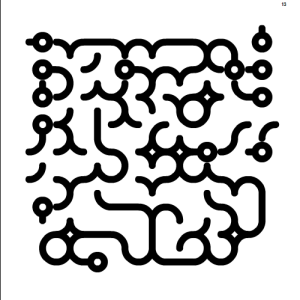
During the first pass, we can make initial deductions about edge and corner pieces.

During the second pass, we can make 2nd-level deductions, such as the orientation of the upper-right corner shape, and it’s mate, as well as several shapes in the upper region of the board.
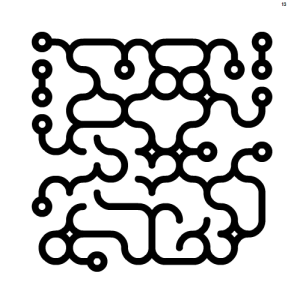
As we move around the board, we can use the rules to traverse outer, indeterminate shapes, finding either a deductive certainty, or making a guess.
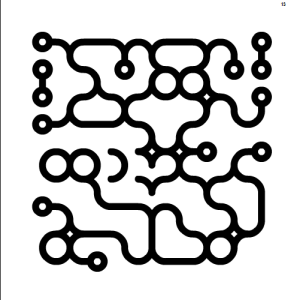
After the next pass, we make deductions regarding the middle left, and lower-right.
Here is the final board position:
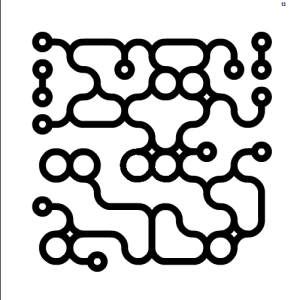
Example 2: Level 14
Original board state:
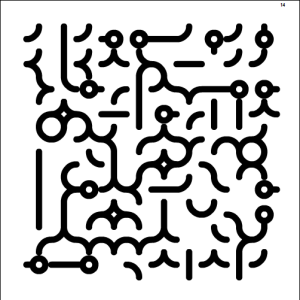
Again, the best strategy is to make an initial pass around the edges, using rule 2.
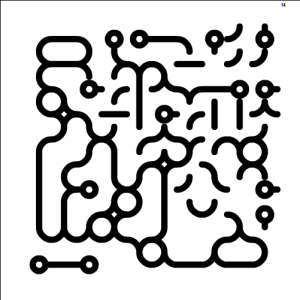
Here is the board state after an initial pass along the left and bottom edges, working inward slightly. In the lower left, we can see some excellent examples of rule 7.
After applying rule 2, we know that the corner – “I” – corner chain must be properly-oriented. Therefore, we know that the “T” directly above it must be oriented with the base of the “T” pointing away. Likewise, on the left edge, we know that the “I” shapes are properly-oriented, and the ones immediately inwardly-adjacent must be parallel.
Further, we know that crosses are always properly-oriented, and we can start to orient adjacent shapes accordingly, such as the line of “I” shapes running from the bottom-middle to the cross near the center.
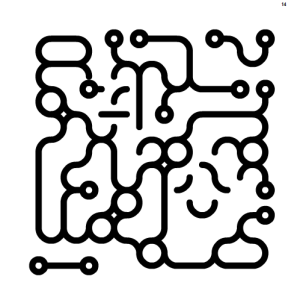
At this point, we’ve completed an “rule 2 tour” around the outer edge, and have worked inward slightly from the top edge.
Noting the “U” shape in the center of the bottom-right quadrant, its two adjacent shapes are corners, and it’s already obvious that the final configuration will be a circle (rules 5 and 6).
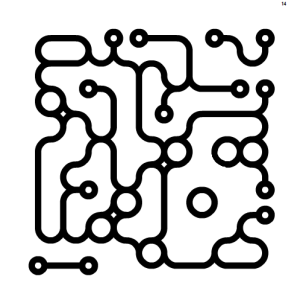
This one was a quick solve.
Note that we had to re-engineer the upper-left quadrant slightly. The two “T” shapes, originally oriented to oppose each other, actually must connect.
As predicted, the “U” shape in the lower-left quadrant indeed forms a circle – noting its position near the vertical line of “I” shapes, all of its corners must face away from them (rule 6).
Example 3: Level 21 (Advanced)
Initial board state:
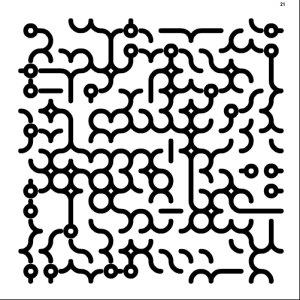
Again, the best way to start is with an “rule 2 tour” of the edges.
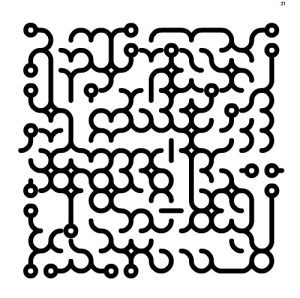
After an “rule 2 tour”, plus working inward on the left.
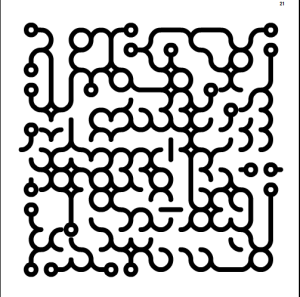
Working inward from the top edge, we make extensive use of rules 7 and 4.

Working inward from the left, we apply rules 5 and 6, and again make extensive use of 4.
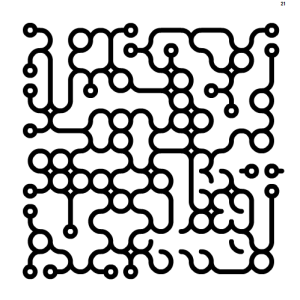
After working on the center and upper-right.
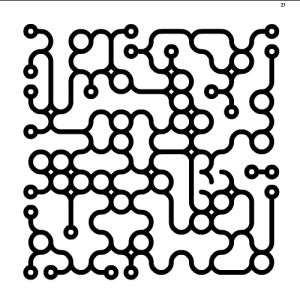
Almost there.

Finished board.
Subjective Analysis
The flash version demonstrated here, is significantly harder than the Android version. After having reached level 1,600 on the Android version, knowing that there are a mix of pre-designed as well as procedurally-generated boards, playing the flash version (ostensibly, the predecessor) was a significantly different experience.
The flash version “ends” at level 51 – after beating 51, it simply repeats level 51 thereafter. Accordingly, the difficulty ramps up significantly faster than the Android version. By level 200 or so (possibly earlier), you’ve seen every possible scenario, including tricky boards with loose ends, or highly-variable boards.
I hit the first few “really difficult” levels in the flash version around level 40!
I recorded a long play of me completing all 52 levels of the flash version (levels 0 through 51), that I will assemble in to a video.
Conclusion
Although a guaranteed logic-based solution to every board is not possible, these strategies allow a systematic and logical attack on every board.
Strategies:
- Work from the edges and corners inward, starting with an “rule 2 tour”.
- Look for crosses (rule 4) and parallel lines (rule 7) to provide clues.
- In situations where a guess is required, opt for the most compact variation, and look for logical contradictions that allow you to sort it out later.
- Use “T” shapes to create or consume an end. Adjacent “T” shapes can be used to create or consume a pair of adjoining ends.
Good luck!